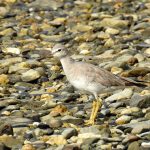WANDERING TATTLER
The Wandering Tattler is a captivating bird that is as mysterious as it is mobile. This medium-sized wader, with its slate-grey plumage and wandering habits, offers a fascinating glimpse into the life of migratory shorebirds. The name “tattler” comes from the bird’s loud, piercing call, which sounds like it’s tattling (reporting) on you as you approach.
The Wandering Tattler primarily breeds in Alaska, across rocky riverine landscapes, which are far from the typical sandy beaches one might associate with shorebirds. After the breeding season, this bird becomes a true globetrotter. It migrates southwards to the coasts of the Pacific Ocean, stretching its wintering range from the western coast of the United States down through Central America, reaching as far as Australia and even some Pacific islands. Australian shores, particularly the eastern and northern coasts, see these birds typically during the Southern Hemisphere summer. This bird is known for its remarkable endurance in flight during migration, capable of flying thousands of kilometers across the open ocean.
The Wandering Tattler can live up to a decade, though much like many wild creatures, their life expectancy is influenced by various factors including predation and habitat conditions.
Their breeding season, starting around May, sees them return to the mountainous terrains of Alaska. They nest on the ground, often choosing spots beside riverbanks where the female lays 3-4 eggs. Both parents share the responsibility of incubating the eggs for about three weeks. The chicks are precocial, meaning they are relatively mature and mobile from the moment of hatching and are cared for by both parents, though they quickly become independent.
The diet of the Wandering Tattler is quite varied, adapting to its surroundings. While in its breeding grounds, it primarily feeds on insects and larvae. However, during migration and in its wintering habitats, its diet shifts to include marine invertebrates such as crustaceans, mollusks, and small fish. They forage by probing and picking along the shoreline, often seen bobbing and teetering along rocks and tidal flats.
The Wandering Tattler is somewhat of an enigma to birdwatchers due to its solitary nature and preference for remote habitats.
In essence, the Wandering Tattler is a testament to the resilience and adaptability of nature. Its life, from navigating vast distances to thriving in varied environments, encapsulates the incredible journeys that many migratory species undertake. Observing these birds can provide not only a sense of wonder but also a deeper appreciation for the intricate migratory networks that crisscross our planet. Their presence along Australian shores is a reminder of the interconnectedness of global ecosystems and the importance of conserving the habitats that these remarkable birds rely on.




